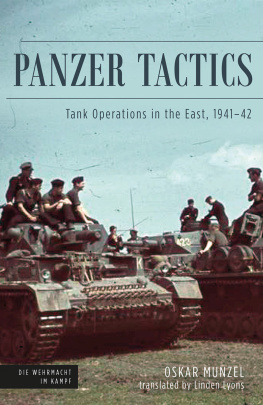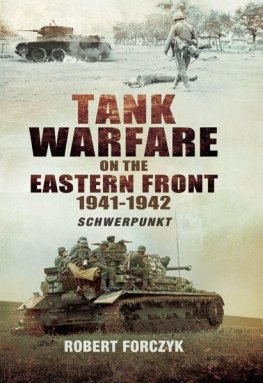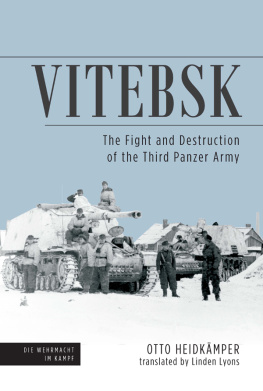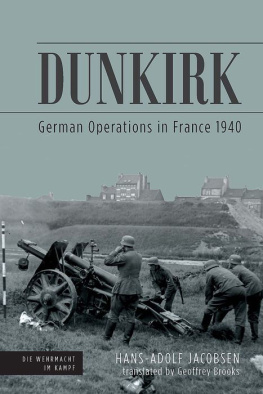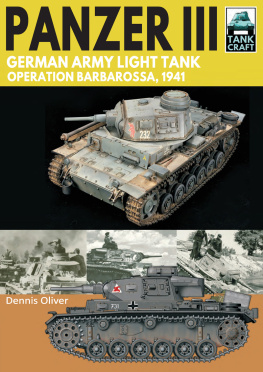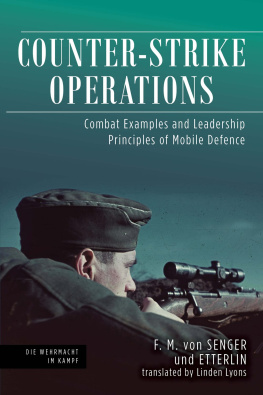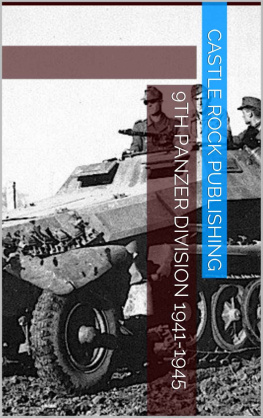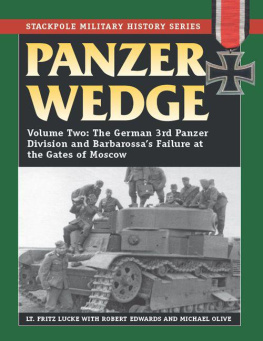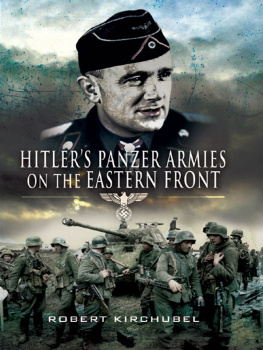Pagebreaks of the print version

DIE WEHRMACHT IM KAMPF
PANZER TACTICS
Tank Operations in the East, 194142
OSKAR MUNZEL
Translated by
LINDEN LYONS
Series editor
MATTHIAS STROHN
AN AUSA BOOK
Association of the United States Army
2425 Wilson Boulevard, Arlington, Virginia, 22201, USA
Published in the United States of America and Great Britain in 2021 by
CASEMATE PUBLISHERS
1950 Lawrence Road, Havertown, PA 19083, USA
and
The Old Music Hall, 106108 Cowley Road, Oxford OX4 1JE, UK
2021 Association of the U.S. Army
English translation Casemate Publishers
Originally published as Die Wehrmacht im Kampf 20: Oskar Munzel, Panzer-Taktik: Raids gepanzerter Verbnde im Ostfeldzug 1941/42 (Scharnhorst Buchkameradschaft GmbH, Neckargemnd, 1959)
Hardback Edition: ISBN 978-1-61200-989-6
Digital Edition: ISBN 978-1-61200-990-2
A CIP record for this book is available from the British Library
All rights reserved. No part of this book may be reproduced or transmitted in any form or by any means, electronic or mechanical including photocopying, recording or by any information storage and retrieval system, without permission from the publisher in writing.
For a complete list of Casemate titles, please contact:
CASEMATE PUBLISHERS (US)
Telephone (610) 853-9131
Fax (610) 853-9146
Email: casemate@casematepublishers.com
www.casematepublishers.com
CASEMATE PUBLISHERS (UK)
Telephone (01865) 241249
Email: casemate-uk@casematepublishers.co.uk
www.casematepublishers.co.uk
Front cover: Bundesarchiv Bild 169 0116
Introduction
The Eastern Front was the decisive theatre of operations during World War II. Approximately 80 per cent of all casualties were sustained here in the titanic clash between National Socialist Germany and the Communist Soviet Union. The first two years saw the occupation of large parts of the Soviet Union during the German summer offensives in 1941 and 1942, respectively. Even though the armoured units and formations formed only a small part of the German (and their allied) troops that fought on the Eastern Front, their mobility and panache was essential in making these gains possible, before the pendulum of war swung irretrievably from (perceived) German superiority to Soviet victory. This book analyses some of the armoured thrusts that occurred on the Eastern Front at that time.
The author of this book, Oskar Munzel, was born in 1899 and joined a cavalry regiment in 1917. His military abilities were spotted by his superiors and he was allowed to remain in the drastically reduced army after World War I. He rose through the ranks and, from June 1941 to September 1943, he served in the 6th Panzer Regiment, which formed part of 3rd Panzer Division that fought on the Eastern Front. In December 1941, Munzel became the commanding officer of this regiment. The division was part of the spear-heads that penetrated deep into Soviet territory, and it was involved in major battles, including the battles of Kiev and Moscow in 1941, and the German thrust towards the Caucasus in 1942. The remainder of the war saw Munzel move between staff positions (including the command of the tank school) and command roles (including divisional and corps command). On 1 December 1944 Munzel was promoted to the rank of Generalmajor. After the war and two years in Allied captivity, Munzel went to Egypt in 1951, where he worked as military advisor for four years. When the West German Bundeswehr was founded in 1955 Munzel quickly re-joined the army. He served as the commandant of the tank school, clearly making use of his previous experience in this role during the war. Later, he became the Inspekteur of the tank forces, and he left the Bundeswehr in 1962 as a Generalmajor, becoming the head of the German military advisory group to Taiwan. He died in Bonn in 1992.
Munzel was thus well equipped to write the study that you, the reader, hold in your hands. He combined practical experience of the command of armoured units and formations with staff posts that had required a more theoretical analysis of this type of warfare. It is therefore not surprising that his writings presented the actual operations and the fighting, but also offered some deep analysis of the actions, their successes and the problems that the German armoured formations had encountered.

